Are you hesitant to consider the Norwegian Elkhound because of its wolf-like appearance?
Rest assured, this distinctive breed is not only a loyal and affectionate companion, but also a versatile working dog with a fascinating history.
From its origins in Norway to its size, temperament, exercise needs, and health considerations, the Norwegian Elkhound has much to offer.
So, if you're looking for a canine companion that will keep you on your toes and bring a unique presence to your home, keep reading to discover more about this remarkable breed.
Key Takeaways
- The Norwegian Elkhound is a working breed with a thick, double coat that is gray or black in color.
- They are intelligent, independent, loyal, and affectionate dogs.
- Norwegian Elkhounds require high levels of exercise and early, consistent training.
- Some health problems that are common in the breed include hip dysplasia, elbow dysplasia, and eye problems.
Origin and Size
The Norwegian Elkhound, a medium-sized dog breed, originated in Norway and is known for its distinctive wolf-like appearance and phenomenal stamina. These dogs have a rich history, with origins dating back as far as 5000 B.C.E., making them one of the world's most ancient breeds.
In terms of size, male Norwegian Elkhounds stand about 20-22 inches tall at the shoulder and weigh between 45-55 pounds, while females are slightly smaller, standing 18-20 inches tall and weighing 35-45 pounds. Despite their medium size, Norwegian Elkhounds have a strong and sturdy build, allowing them to excel in their original purpose as moose hunters.
Their size, combined with their endurance and agility, makes them well-suited for various outdoor activities.
Breed Group and Lifespan
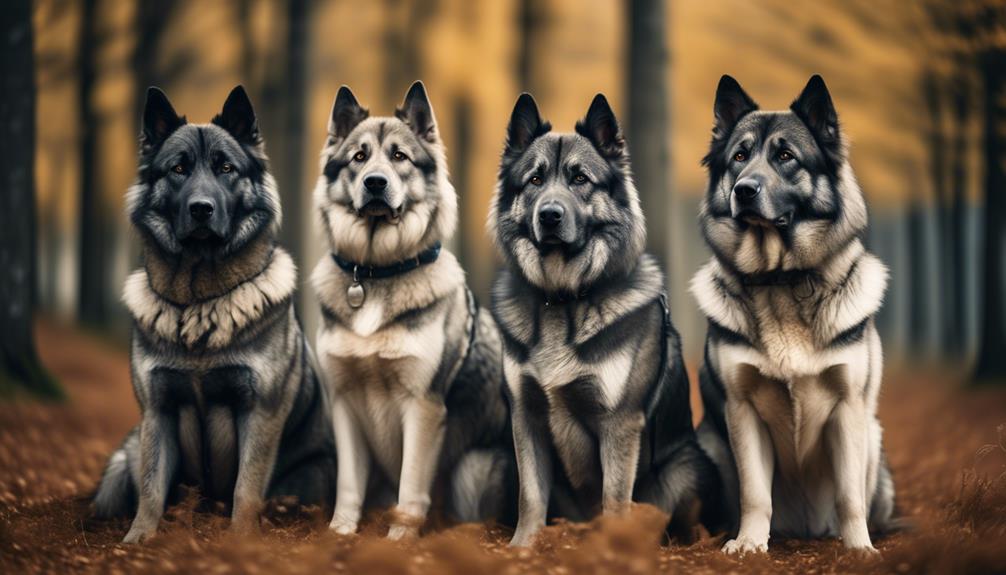
To understand the Norwegian Elkhound breed better, it's important to explore their breed group and lifespan. Norwegian Elkhounds belong to the Working group, which consists of dogs that were historically bred for various tasks such as pulling sleds, guarding property, and assisting in hunting. These dogs are known for their intelligence, strength, and endurance. As for their lifespan, Norwegian Elkhounds typically live for 12 to 15 years. This means that if you decide to bring a Norwegian Elkhound into your life, you can expect to have a loyal and devoted companion for over a decade. Remember to provide them with regular exercise and mental stimulation to ensure their well-being and happiness.
| Breed Group | Lifespan |
|---|---|
| Working | 12-15 years |
Coat and Temperament
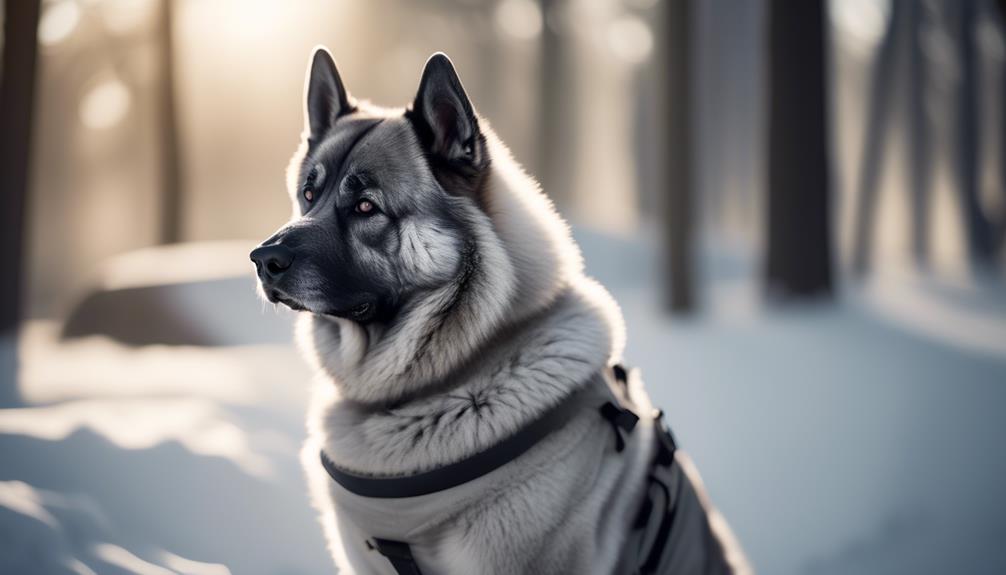
Get ready to explore the Norwegian Elkhound's distinctive coat and temperament.
The Norwegian Elkhound has a thick, double coat that's gray or black in color. Its coat is weather-resistant, with a short, thick topcoat and a dense, woolly undercoat. The Elkhound's coat is known for its silver accents, black tipping on the ears and tail, and darker gray coloring on the saddle.
When it comes to temperament, the Norwegian Elkhound is intelligent, independent, loyal, and affectionate. This breed is known for its protective nature and loyalty to its family. However, they can also be independent thinkers and require consistent training and socialization.
Exercise Needs and Training
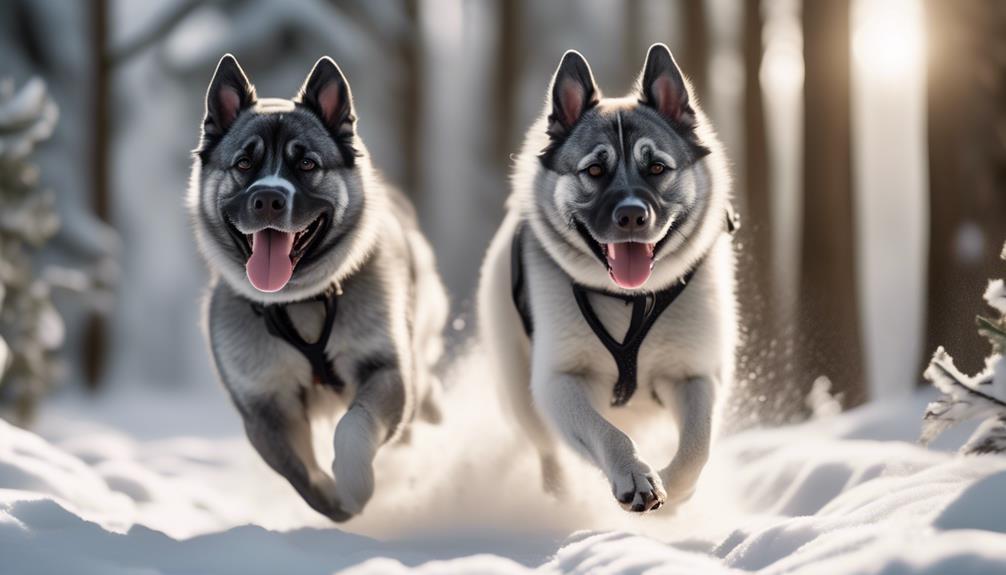
Maintaining an active lifestyle and providing consistent training are essential for meeting the exercise needs and ensuring the well-being of your Norwegian Elkhound. These dogs have high exercise needs due to their energetic nature and stamina. Daily exercise is necessary to keep them physically and mentally stimulated. Engaging in activities such as long walks, jogs, hikes, or playing fetch in a securely fenced area will help burn off their energy.
Training is also crucial for Norwegian Elkhounds, as they can be independent thinkers. Early and consistent training will help establish boundaries and teach them proper behavior. Positive reinforcement techniques, such as rewards and praise, work best with this breed.
With the right amount of exercise and training, your Norwegian Elkhound will be a happy and well-behaved companion.
Common Health Problems
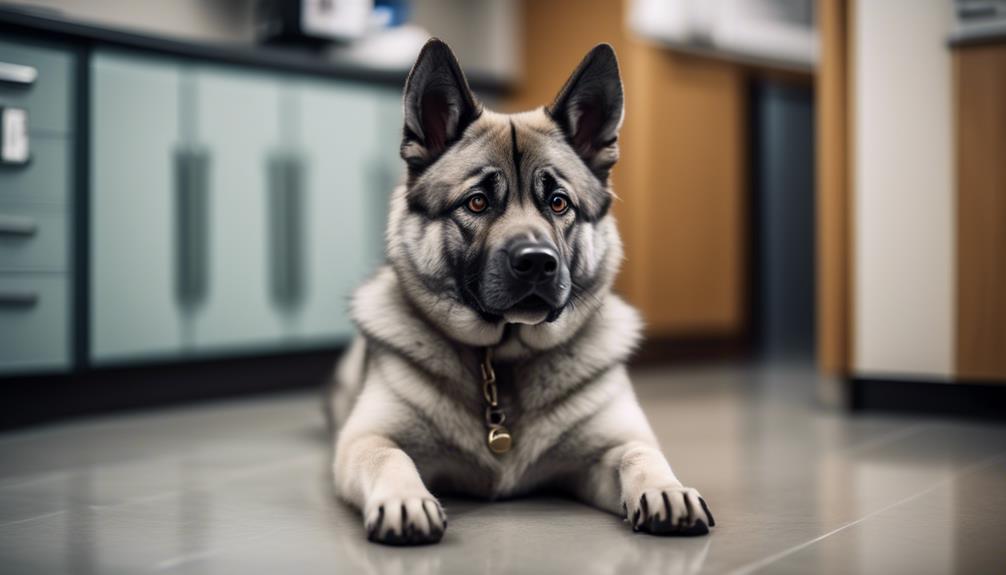
Now let's shift our focus to the common health problems that can affect Norwegian Elkhounds. It's important to be aware of these issues so you can provide the best care for your furry friend. Here are some common health problems to watch out for:
- Hip dysplasia: This is a condition where the hip joint doesn't develop properly, leading to pain and mobility issues.
- Elbow dysplasia: Similar to hip dysplasia, but affecting the elbow joint. It can cause lameness and discomfort.
- Eye problems: Norwegian Elkhounds are prone to certain eye conditions such as progressive retinal atrophy (PRA) and cataracts.
- Hypothyroidism: This is a disorder where the thyroid gland doesn't produce enough hormones, leading to weight gain, lethargy, and skin issues.
- Fanconi Syndrome: This is a rare kidney disorder that affects the ability to absorb nutrients and remove waste products from the body.
Regular check-ups with a veterinarian can help catch these problems early and ensure your Norwegian Elkhound stays happy and healthy.
Historical Significance
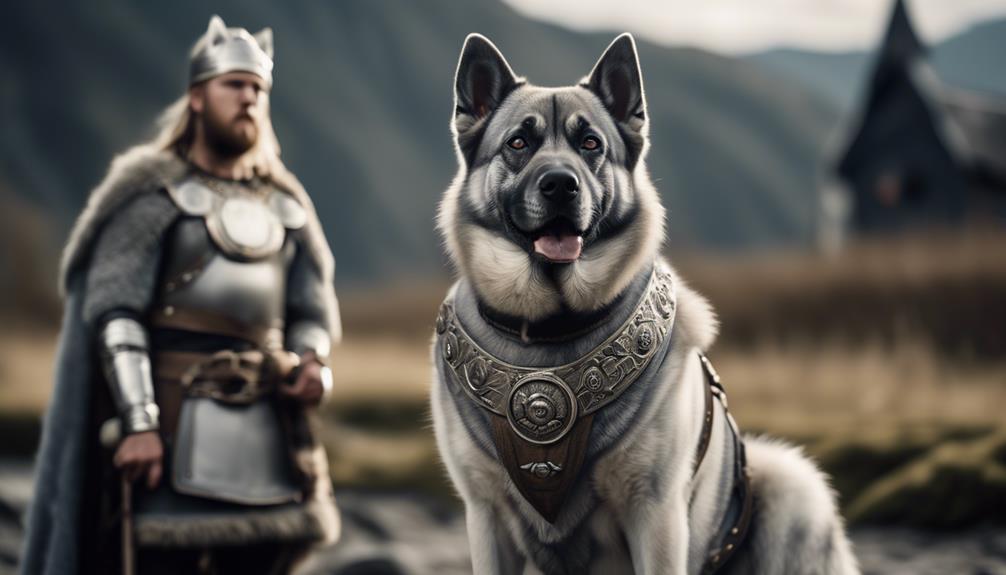
Norwegian Elkhounds have a rich historical significance, dating back as far as 5000 B.C.E., making them one of the world's most ancient dog breeds. These dogs were originally used by Vikings for guarding and hunting, and they have been a common fixture in Norwegian culture for centuries. They were used to guard herds, flocks, and homes, as well as to hunt large game. The Norwegian Elkhound's lineage can be traced back to their ancient ancestors, who roamed the Scandinavian region thousands of years ago. Today, they are still known for their loyalty, protective nature, and distinctive wolf-like appearance. Below is a table summarizing the historical significance of the Norwegian Elkhound:
| Time Period | Significance |
|---|---|
| 5000 B.C.E. | Origins of the breed |
| Viking Age | Used for hunting |
| Norwegian Culture | Common and revered |
| Ancient Ancestors | Roamed Scandinavia |
| Present Day | Still a beloved breed |
The historical significance of the Norwegian Elkhound showcases their enduring legacy and their importance in the cultural and hunting traditions of Norway.
Distinctive Appearance
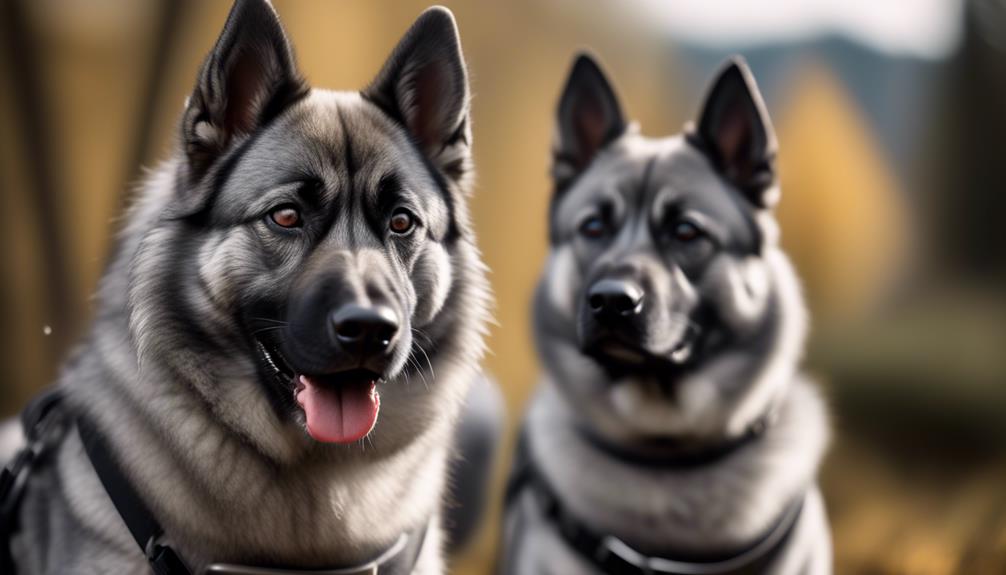
With their distinctive wolf-like appearance, Norwegian Elkhounds are easily recognizable among other dog breeds. Here are five key features that contribute to their unique look:
- Curled Tail: Norwegian Elkhounds have a tightly curled tail that rests on their back, adding to their regal and majestic appearance.
- Erect Ears: Their ears stand tall and alert, giving them a keen and attentive expression.
- Thick Double Coat: Elkhounds have a thick, weather-resistant double coat that keeps them warm in cold climates. The topcoat is short and dense, while the undercoat is soft and woolly.
- Gray or Black Coloring: Their coat is predominantly gray or black, with black-tipped guard hairs and silver accents. The saddle area tends to be darker, while the chest and mane are lighter in color.
- Rugged Build: Norwegian Elkhounds have a sturdy and muscular build, reflecting their history as working dogs bred for hunting and guarding.
Characteristics and Care
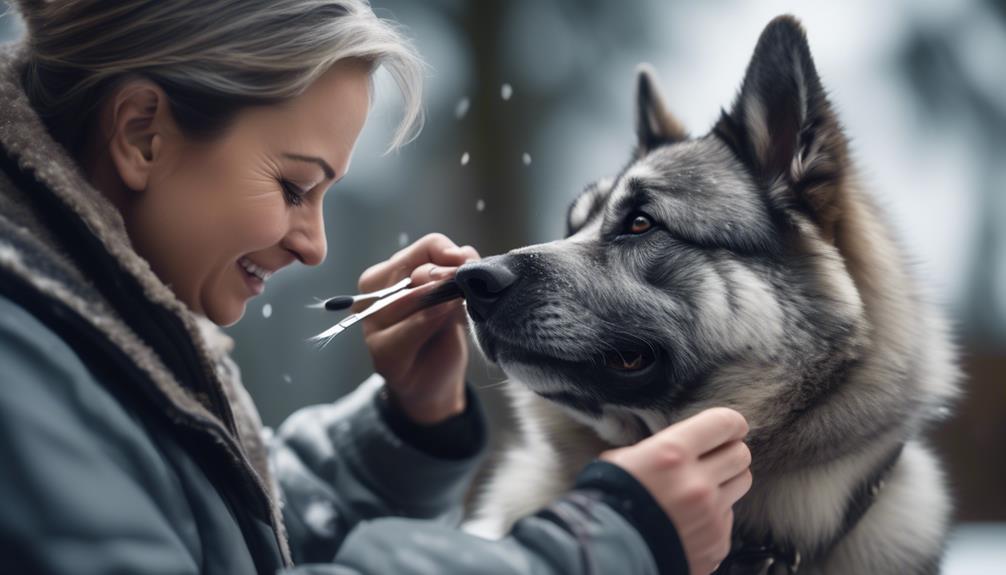
After exploring the distinctive appearance of Norwegian Elkhounds, let's now dive into their characteristics and care.
Norwegian Elkhounds are intelligent, independent, loyal, and affectionate dogs. They've a strong prey drive and need regular exercise and mental stimulation. Training them can be challenging due to their independent nature, but early and consistent training is necessary.
Some common health problems in the breed include hip dysplasia, elbow dysplasia, and eye problems. They've a thick, double coat that requires regular grooming to keep it in good condition. Norwegian Elkhounds are well-suited for cold climates due to their thick coat and rugged build.
They're known for their loyalty and protective nature, making them great family companions.
Frequently Asked Questions
Are Norwegian Elkhounds Good With Children and Other Pets?
Yes, Norwegian Elkhounds are generally good with children and other pets. However, it's important to provide obedience training and supervision, as they can become dominant if not properly trained.
How Much Exercise Do Norwegian Elkhounds Need on a Daily Basis?
Norwegian Elkhounds need a significant amount of exercise on a daily basis. You should aim for long walks, vigorous play sessions, and mental stimulation to keep them happy and healthy.
Do Norwegian Elkhounds Have Any Unique Grooming Needs?
No, Norwegian Elkhounds do not have any unique grooming needs. They have a double coat that is weather-resistant and requires regular brushing to remove loose hair. Other than that, their grooming needs are similar to other dog breeds.
Can Norwegian Elkhounds Live in Apartments or Do They Require a Large, Outdoor Space?
Norwegian Elkhounds can adapt to apartment living, but they still require regular exercise. Prioritize their exercise needs over their size. Consider their barking tendencies and prioritize qualities like being calm and low-energy when living in close proximity to others.
Are Norwegian Elkhounds Prone to Any Specific Behavioral Issues or Challenges?
Norwegian Elkhounds can be prone to certain behavioral challenges due to their independent nature. Obedience training may be challenging, and they require consistent training and socialization to prevent dominance issues, especially towards children and other dogs.
What are the similarities and differences between the Norwegian Elkhound and the Irish Wolfhound breeds?
The Norwegian Elkhound and the Irish Wolfhound breeds share a strong loyalty to their owners and are known for their protective nature. However, the Irish Wolfhound is notably larger in size compared to the Norwegian Elkhound. Both breeds require regular exercise and grooming to maintain their well-being. For more irish wolfhound characteristics information, consult a breed expert.
Conclusion
In conclusion, the Norwegian Elkhound is a loyal and affectionate canine companion with a rich history and distinctive appearance.
This medium-sized working dog is well-suited for outdoor adventures and requires daily exercise to keep its high energy levels in check.
While their independent nature may present training challenges, Norwegian Elkhounds are devoted to their families and make excellent protectors.
Whether you live in an apartment or have a spacious home, the Norwegian Elkhound can be a wonderful addition to your family, bringing loyalty, playfulness, and a distinctive bark that will always keep you alert.




